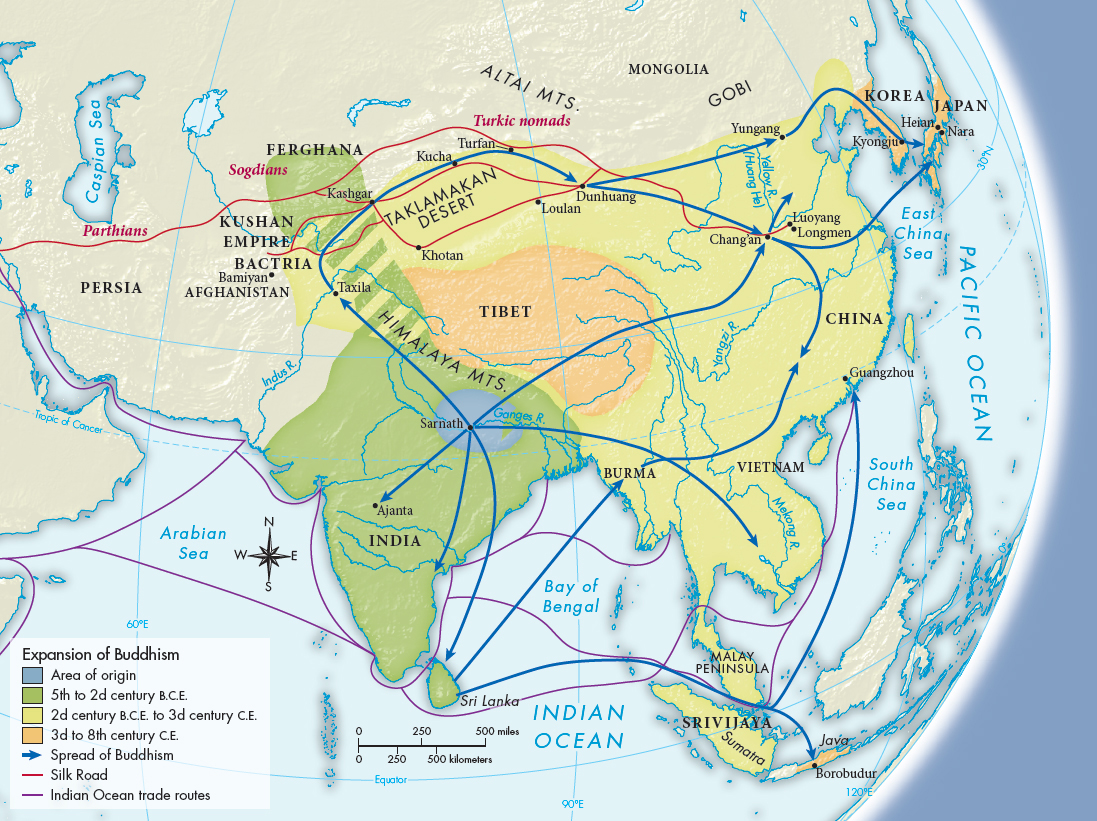A History of World Societies:
Printed Page 189
A History of World Societies Value
Edition: Printed Page 186
Chapter Chronology
Buddhism’s Path Through Central Asia
Central Asia is a loose term used to refer to the vast area between the ancient civilizations of Persia, India, and China. Modern political borders are a product of competition for empire among the British, Russians, and Chinese in the mid-nineteenth century and have relatively little to do with the earlier history of the region. Through most of recorded history, the region was ethnically and culturally diverse; it was home to urban centers, especially at the oases along the Silk Road, and to animal herders in the mountains and grasslands.
Under Ashoka in India (see pages “The Reign of Ashoka, ca. 269-232 B.C.E.” in Chapter 3), Buddhism began to spread to Central Asia. This continued under the Kushan empire (ca. 50–250 C.E.), especially under the greatest Kushan king, Kanishka I (ca. 100 C.E.). In this region, where the influence of Greek art was strong, artists began to depict the Buddha in human form. Over the next several centuries most of the city-states of Central Asia became centers of Buddhism, from Bamiyan northwest of Kabul, to Kucha, Khotan, Loulan, Turfan, and Dunhuang (Map 7.3). Because the remarkable Buddhist civilization of Central Asia was later supplanted by Islam, it was not until early in the twentieth century that European archaeologists discovered its traces. The main sites yielded not only numerous Buddhist paintings but also thousands of texts in a variety of languages. In Khotan, for instance, an Indian language was used for administrative purposes long after the fall of the Kushan empire. Other texts were in various Persian languages, showing the cultural mix of the region.

Mapping the PastMAP 7.3 The Spread of Buddhism, ca. 500 B.C.E.–800 C.E. Buddhism spread throughout India in Ashoka’s time and beyond India in later centuries. The different forms of Buddhism found in Asia today reflect this history. The Mahayana Buddhism of Japan came via Central Asia, China, and Korea, with a secondary later route through Tibet. The Theravada Buddhism of Southeast Asia came directly from India and indirectly through Sri Lanka.ANALYZING THE MAP Trace the routes of the spread of Buddhism by time period. How fast did Buddhism spread?CONNECTIONS Why do you think Buddhism spread more to the east of India than to the west?
The form of Buddhism that spread from Central Asia to China, Japan, and Korea was called Mahayana, which means “Great Vehicle” (see “Siddhartha Gautama and Buddhism” in Chapter 3), reflecting the claims of its adherents to a more inclusive form of the religion. Influenced by the Iranian religions then prevalent in Central Asia, Buddhism became more devotional. The Buddha came to be treated as a god, the head of an expanding pantheon of other Buddhas and bodhisattvas (Buddhas-to-be). With the growth of this pantheon, Buddhism became as much a religion for laypeople as for monks and nuns.
The first translators of Buddhist texts into Chinese were not Indians but Parthians, Sogdians, and Kushans from Central Asia. One of the most important interpreters of Buddhism in China was the eminent Central Asian monk Kumarajiva (350–413) from Kucha, who settled in Chang’an and directed several thousand monks in the translation of Buddhist texts.
